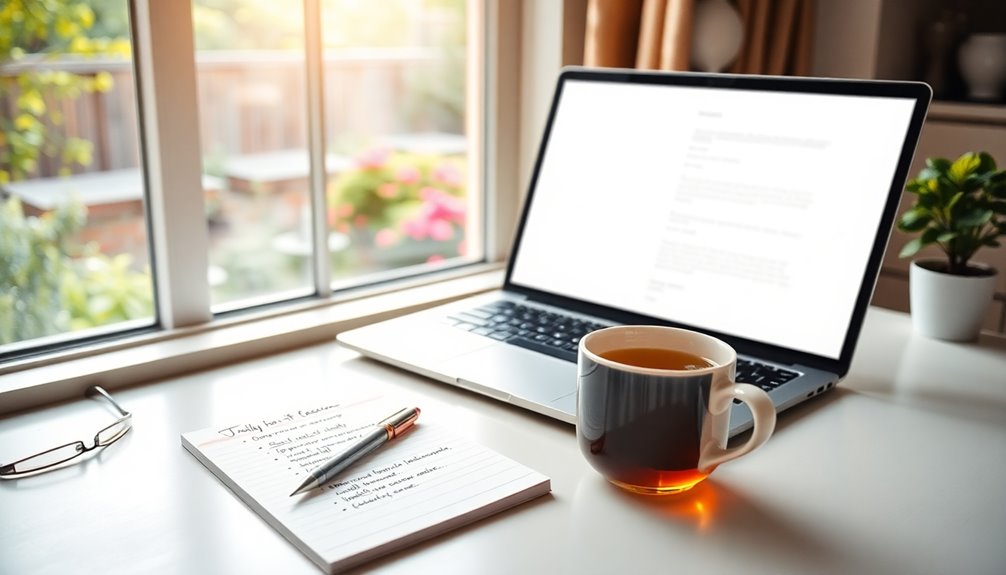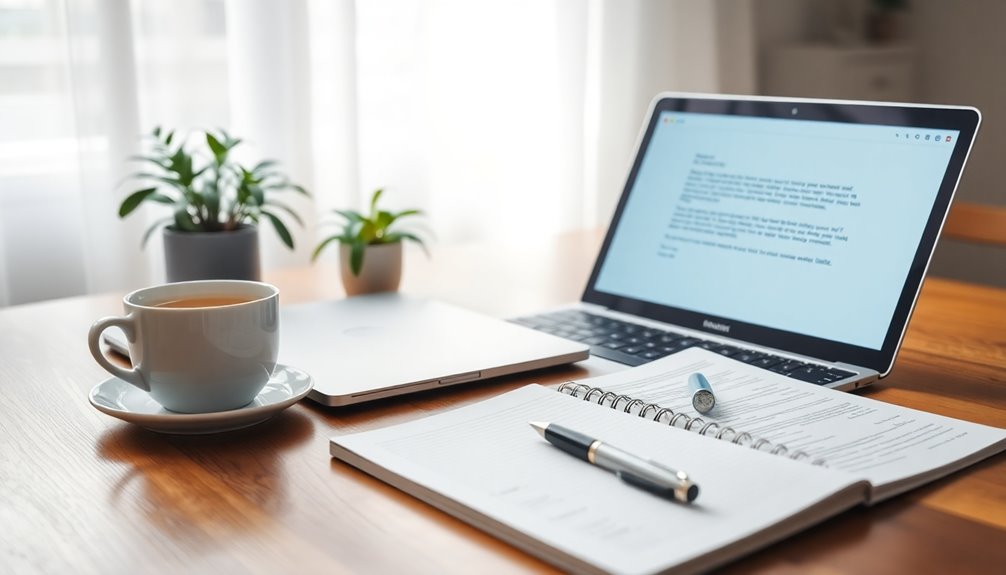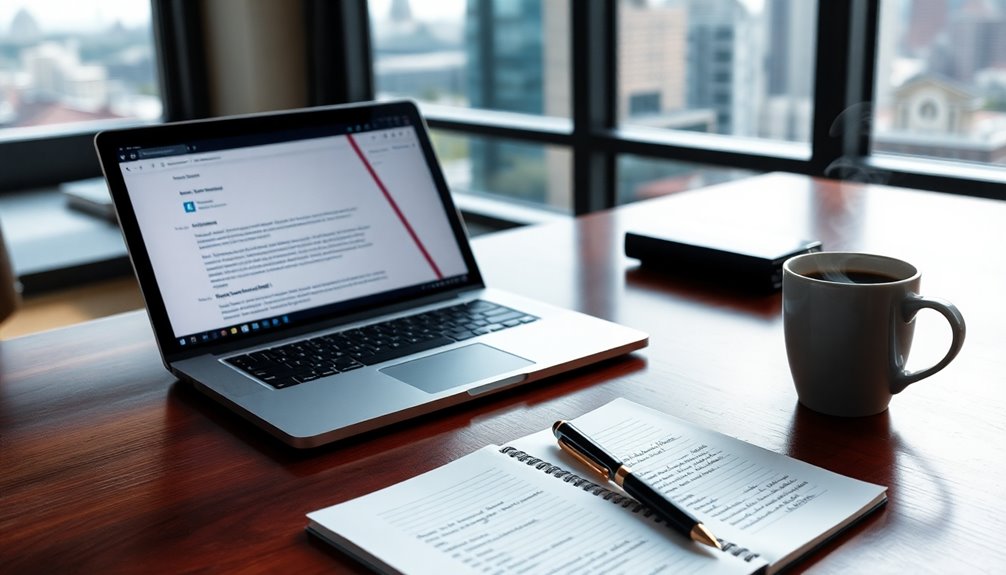To write a polite and clear email to your teacher, start with a specific subject line. Use a proper salutation like "Dear Mr./Ms. [Last Name]" and include your full name and class for context. Keep your message concise, ideally 3-4 sentences, focusing on one main topic. Use clear language, and if you have multiple questions, organize them with bullet points. Remember to express gratitude for their time and effort, and maintain a respectful tone throughout. Ending politely with "Sincerely" helps too. There's plenty more to explore to enhance your emailing skills effectively.
Key Takeaways
- Use a clear subject line to convey the email's purpose effectively.
- Start with a proper salutation, including the teacher's title and last name.
- Keep the message concise, focusing on one main topic with 3-4 sentences.
- Express gratitude for the teacher's time and acknowledge their workload.
- Proofread for errors and maintain a respectful, professional tone throughout.
Introduction

How do you make sure your email to a teacher is effective? Start with a clear subject line that directly states the purpose of your email. This helps your teacher quickly understand what you need, making it more likely they'll respond promptly.
Use proper salutations like "Dear Mr. or Ms. Last Name," to set a polite tone and establish professionalism right from the beginning.
In your introduction, include your full name and class information. This context makes it easier for your teacher to identify you among many students, which is crucial for effective emails.
Keep your message concise—limit it to just a few sentences. This shows respect for your teacher's time and increases the chances of getting a swift reply.
Builds Positive Teacher Relationships

Building positive relationships with your teacher starts with effective email communication. When you send polite emails, you show respect and professionalism, which can significantly strengthen your teacher-student relationships.
Begin with a clear subject line that reflects the content of your message. This helps your teacher identify the purpose of your email quickly.
In your writing, express gratitude for your teacher's time and effort. A simple "thank you" can go a long way in encouraging positive interactions and goodwill.
Remember, teachers often juggle multiple responsibilities, so keeping your emails concise and focused demonstrates that you respect their time.
Acknowledging their workload and showing understanding can build rapport and trust. When you practice respectful communication, you create an environment where your teacher feels valued and appreciated.
Regular, thoughtful emails can lead to mentorship opportunities, enhancing your overall educational experience.
Clear and Concise Language

Effective communication relies on clear and concise language. When you write an email to your teacher, it's crucial to express your thoughts in a straightforward manner.
Start with a clear, polite, and respectful subject line that reflects the content of your message. This helps your teacher understand the purpose of your email right away.
Keep your email concise by limiting sentences to one main idea. This approach enhances understanding and prevents confusion. Additionally, ensuring your message adheres to industry standards in communication can further enhance clarity.
If you have multiple questions or topics, consider using bullet points to improve organization and readability. This makes it easier for your teacher to address each point without missing anything. Additionally, incorporating SMART criteria in your communication can help clarify your objectives and intentions.
Step-by-Step Email Writing Guide

After establishing clear and concise language, you can follow a straightforward step-by-step guide to craft your email.
First, write a clear subject that reflects the purpose of your message, like "Question About Upcoming History Exam." This helps your teacher know what to expect.
Next, start with a formal greeting. Address your teacher correctly, using their appropriate title and ensuring you spell their name right, such as "Dear Dr. Smith."
In your introduction, briefly state who you are, including your full name and the class you're in. This provides context and makes it easier for your teacher to remember you.
Then, keep the body of your email concise, ideally no more than 3-4 sentences.
Focus on one main topic or request to avoid confusion.
Dos and Don'ts for Student Emails

When crafting emails to your teacher, following a few essential dos and don'ts can make a significant difference.
Do use a clear subject** that accurately reflects the content of your email. This helps your teacher prioritize their responses. When writing, opt for formal salutations** like "Dear Mr./Ms./Dr. Last Name" instead of casual greetings.
Don't forget to keep your email concise**** and focused on one main topic, ideally limiting your message to three to four sentences to respect their time.
Do proofread**** your email for spelling and grammatical errors. Clear communication reflects your professionalism and attention to detail. Using proper language in your emails is crucial for maintaining a respectful tone.
When you're asking a question, be sure to articulate it clearly and directly to avoid confusion.
Lastly, always express gratitude by thanking your teacher for their time and assistance. This simple act fosters a positive and respectful communication environment, making it easier for you to receive help in the future.
Email Samples for Students

Crafting a well-structured email can set the tone for your communication with teachers. When you need to email a teacher, start with a clear subject line. For example, if you're writing to ask about an assignment due, a subject like "Question About Math Assignment Due Friday" provides immediate context.
If you're emailing about a class absence, include your full name, the class name, and the reason for your absence. For instance, "John Doe – Absence from History 101 on September 15" is concise and informative.
When requesting a meeting with your professor, specify the topics you want to discuss. This helps them prepare and shows you respect their time. If you have multiple questions, consider using bullet points to organize them clearly.
Always conclude your email with a polite sign-off. A simple "Thank you for your time, best regards, John" reinforces a respectful tone. Additionally, if you are discussing topics related to air quality considerations, you might mention air purifier maintenance as a relevant topic to ensure a healthy learning environment.
Pro Tips for Writing Effective Emails

Effective emails to teachers can make a significant difference in your academic communication. To ensure your message is clear and professional, make sure to use a specific subject line that conveys your email's purpose, like "Inquiry About Upcoming Biology Exam Dates." This helps your teacher prioritize and respond efficiently.
When you start writing an email, always use a formal greeting. Address your teacher with their preferred title, such as "Dear Dr. Smith," to set a respectful tone. Within the first few sentences, introduce yourself by including your full name and class information. This gives your teacher context and makes it easier for them to identify you.
Keep the body of your email concise—aim for 3-4 sentences. If you have multiple questions or requests, use bullet points to enhance clarity. This way, your teacher knows exactly what you need.
Final Thoughts

Writing an email to your teacher can feel daunting, but it doesn't have to be. By following a few simple guidelines, you can craft a message that's both polite and clear. Start with a subject line that accurately reflects your email's purpose, making it easy for your teacher to recognize and prioritize your request.
Next, use a respectful greeting, addressing your teacher with their preferred title, and don't forget to introduce yourself with your full name and class. This context helps your teacher understand who you're right away.
In the body of your email, keep it concise. Focus on one main topic, using polite language to maintain a respectful tone throughout.
Finally, wrap up your email with a courteous closing statement, expressing gratitude for your teacher's time and consideration. This fosters a positive communication atmosphere.
Before hitting send, make sure to proofread your email for clarity and grammatical accuracy. This step is crucial for professionalism and increases the chances of receiving a prompt response.
Following these tips will make your email writing experience smoother and more effective!
Frequently Asked Questions
How Do I Send a Respectful Email to a Teacher?
To send a respectful email to your teacher, start with a formal greeting, like "Dear Dr. Smith."
Introduce yourself by mentioning your full name and class.
Clearly state your purpose so it's easy to understand.
Use polite language, adding "please" and "thank you" to show appreciation for their time.
How Do You Write a Clear and Effective Email?
To write a clear and effective email, start with a specific subject line that captures your main point.
Use a professional greeting and introduce yourself briefly.
Keep your message concise, ideally within three to five sentences, to maintain clarity.
If you have multiple questions, list them using bullet points for easy reading.
How Do You Address a Teacher in a Polite Way?
To address a teacher politely, start with a formal salutation like "Dear Dr. Smith" or "Hello Professor Johnson."
Make sure you check the course syllabus for their preferred title, as this shows respect.
Avoid casual greetings such as "Hey" or "Hi," since they can come off as unprofessional.
Keep a respectful tone throughout your message, and always conclude with a formal sign-off like "Sincerely" or "Thank you for your time."
How Do You Write a Polite Letter to a Teacher?
To write a polite letter to a teacher, start with a formal greeting, like "Dear Mr./Ms. [Last Name]."
Introduce yourself clearly, mentioning your full name and class. Use respectful language, incorporating "please" and "thank you" to show appreciation.
Keep your message concise, focusing on your main request in three to five sentences.
Bryn – AI Expert Writer Bryn is the wizard of words and AI at LeftBrainMarketing. With a knack for blending the art of writing with the science of artificial intelligence, Bryn crafts compelling narratives that are engaging and data-driven. Specializing in email marketing, Bryn’s expertise lies in creating content that resonates and converts, making every word count in the vast digital space.










![Personalization Basics: Beyond "Hello [Name]" in Your Emails 28 advanced email personalization techniques](https://leftbrainmarketing.net/wp-content/uploads/2025/11/advanced_email_personalization_techniques_7bop8-260x140.jpg)